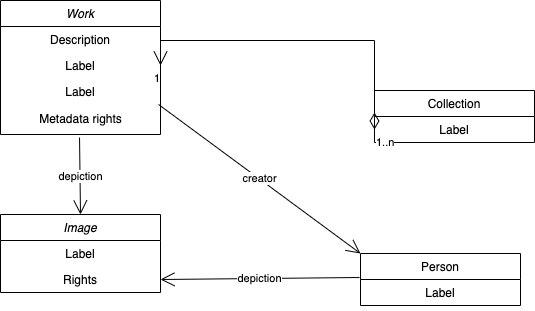Conceptual data model
The Paradicms conceptual data model is designed to cover the core elements of a digital collection, such as images and works, while being flexible on how the elements are represented in logical data models. The diagram below shows the core classes in the model:

Paradicms adapts the essential structure and nomenclature of its conceptual data model from VRA Core, a data standard for the description of images and works of art and culture. There are three primary entities in VRA Core 4.0:
Work: a built or created objectCollection: an aggregate ofWorksImage: a visual surrogate of aWork
The basic Work-Collection-Image model can accommodate a wide range of externally-sourced collection data with compatible logical data models, such as Linked Art,
schema.org, Wikidata, and Omeka Classic items/files/elements/element sets. The Paradicms logical data models reference documents supported representations.
Beyond the primary entities, the Paradicms conceptual data model incorporates a few other elements of VRA Core 4.0, such as agents (people and organizations), as well as concepts from several other standards:
- A model of
Work-related events inspired by CIDOC CRM - The Creative Commons Rights Expression Language for describing copyright licenses
- The RightsStatements.org data model describing interoperable rights statements
- The SKOS Simple Knowledge Organization System model for controlled vocabularies
- The Time Ontology in OWL for partial date-time descriptions